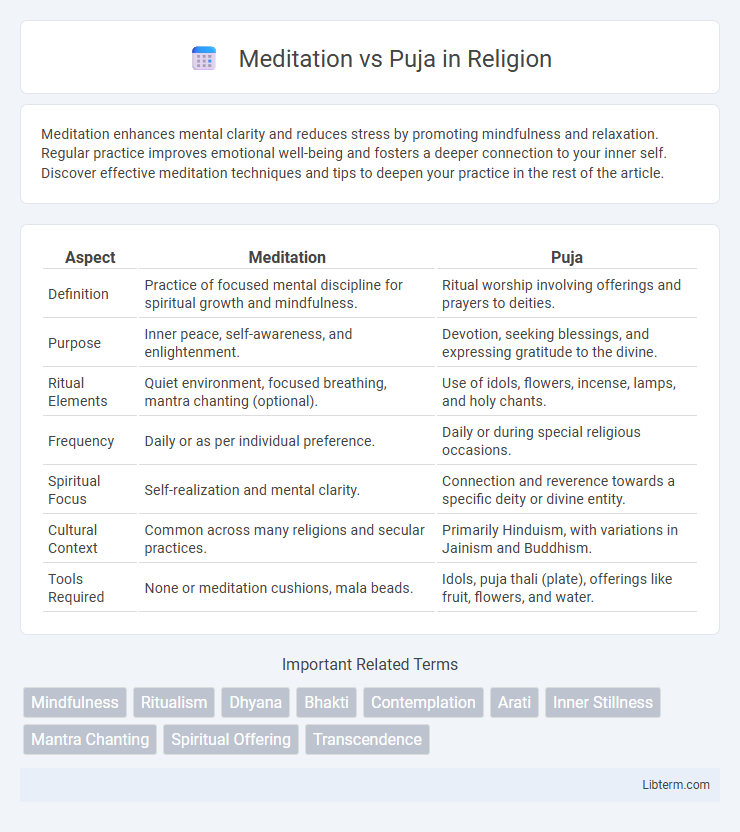Meditation enhances mental clarity and reduces stress by promoting mindfulness and relaxation. Regular practice improves emotional well-being and fosters a deeper connection to your inner self. Discover effective meditation techniques and tips to deepen your practice in the rest of the article.
Table of Comparison
| Aspect | Meditation | Puja |
|---|---|---|
| Definition | Practice of focused mental discipline for spiritual growth and mindfulness. | Ritual worship involving offerings and prayers to deities. |
| Purpose | Inner peace, self-awareness, and enlightenment. | Devotion, seeking blessings, and expressing gratitude to the divine. |
| Ritual Elements | Quiet environment, focused breathing, mantra chanting (optional). | Use of idols, flowers, incense, lamps, and holy chants. |
| Frequency | Daily or as per individual preference. | Daily or during special religious occasions. |
| Spiritual Focus | Self-realization and mental clarity. | Connection and reverence towards a specific deity or divine entity. |
| Cultural Context | Common across many religions and secular practices. | Primarily Hinduism, with variations in Jainism and Buddhism. |
| Tools Required | None or meditation cushions, mala beads. | Idols, puja thali (plate), offerings like fruit, flowers, and water. |
Introduction to Meditation and Puja
Meditation is a practice centered on achieving mental clarity, emotional calmness, and heightened awareness through focused breathing, mindfulness, or mantra repetition. Puja, a ritualistic worship in Hinduism, involves offerings, prayers, and chants directed toward deities to express devotion and seek blessings. Both Meditation and Puja serve as spiritual tools but differ in approach--Meditation emphasizes internal stillness, while Puja emphasizes external expressions of reverence.
Historical Origins and Cultural Significance
Meditation originated in ancient India as a spiritual practice aimed at achieving mental clarity and enlightenment, predominantly within Hinduism and later Buddhism. Puja, also rooted in Indian tradition, is a ritualistic worship performed to honor deities, involving offerings and prayers to invoke divine blessings. Both meditation and puja hold deep cultural significance, with meditation fostering personal spiritual growth and puja reinforcing community bonds through ceremonial worship.
Core Principles and Philosophies
Meditation centers on inner awareness and mental clarity, emphasizing mindfulness and self-realization as core principles rooted in practices like Vipassana and Zen. Puja involves ritualistic worship and offering to deities, focusing on devotion, gratitude, and connecting with divine energies within Hindu and Buddhist traditions. Both practices aim for spiritual growth but differ fundamentally: meditation is introspective and individual, while puja is expressive and communal.
Methods and Practices Compared
Meditation involves silent, focused attention using techniques like mindfulness, breath control, or mantra repetition to achieve mental clarity and inner peace. Puja consists of ritualistic worship in Hinduism, incorporating offerings, chanting, and devotional acts to honor deities and invite divine blessings. Meditation emphasizes inward self-awareness, while Puja centers on external expressions of reverence through ceremonial practices.
Purpose: Inner Peace vs Devotional Connection
Meditation aims to cultivate inner peace by calming the mind and enhancing self-awareness through focused attention and mindfulness techniques. Puja serves as a devotional practice that fosters a deep spiritual connection with deities, emphasizing ritualistic offerings and prayers to express reverence and seek blessings. Both practices contribute to mental well-being, but meditation prioritizes personal tranquility while puja centers on religious devotion.
Tools and Rituals in Practice
Meditation primarily involves minimal tools, focusing on breath control, mantra chanting, or visualization techniques to cultivate inner awareness and mental clarity. Puja incorporates various ritualistic tools such as incense, lamps, flowers, and sacred water, performed in a structured sequence to honor deities and invoke spiritual blessings. The ritualistic complexity of puja contrasts with the simplicity of meditation, emphasizing external offerings versus internal focus.
Benefits: Mental, Emotional, and Spiritual
Meditation enhances mental clarity, reduces stress, and promotes emotional stability by fostering mindfulness and inner calm. Puja strengthens spiritual connection and devotion, offering emotional comfort through ritual and communal worship. Both practices cultivate a deeper sense of peace, balance, and spiritual growth.
Common Misconceptions
Meditation and puja are often misunderstood as interchangeable spiritual practices, but they serve distinct purposes; meditation focuses on inward reflection and mental clarity, while puja involves ritualistic worship and offering to deities. A common misconception is that meditation requires external objects or idols, whereas it primarily involves self-awareness and mindfulness without physical props. Puja, though sometimes viewed merely as ceremonial, is rich in symbolic actions meant to deepen devotion, contradicting the belief that it is a superficial or purely performative act.
Choosing Between Meditation and Puja
Choosing between meditation and puja depends on one's spiritual goals and personal inclination; meditation offers an inward-focused practice promoting mindfulness and self-awareness, while puja emphasizes ritualistic worship and connection with deities. Meditation enhances mental clarity and emotional balance through silent contemplation, whereas puja involves chanting, offerings, and ceremonial acts that foster devotion and community participation. Evaluating whether one seeks contemplative solitude or expressive reverence helps determine the preferred spiritual practice.
Integrating Both Practices for Holistic Well-being
Meditation and Puja complement each other by combining mindfulness with devotional rituals, enhancing spiritual and mental well-being. Integrating meditation practices during Puja rituals deepens focus and cultivates inner peace, while the ritualistic aspect of Puja enriches meditation by invoking a sense of sacred connection. This holistic approach balances self-awareness and reverence, promoting emotional harmony and fostering overall health.
Meditation Infographic

 libterm.com
libterm.com